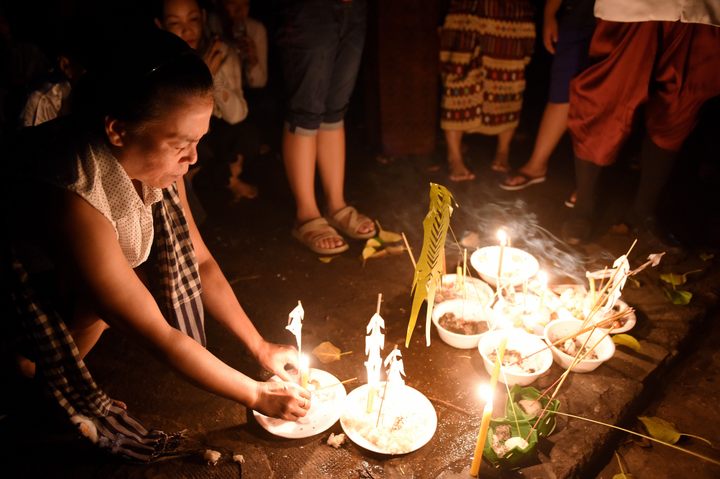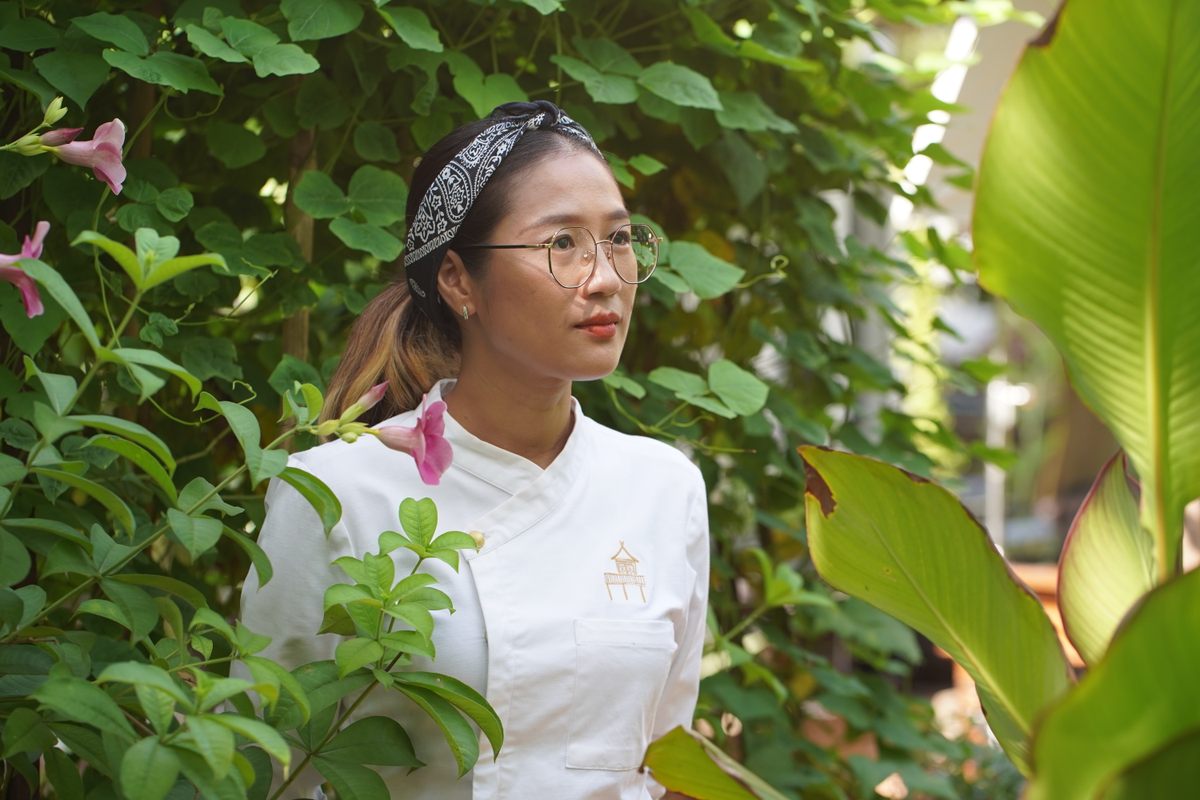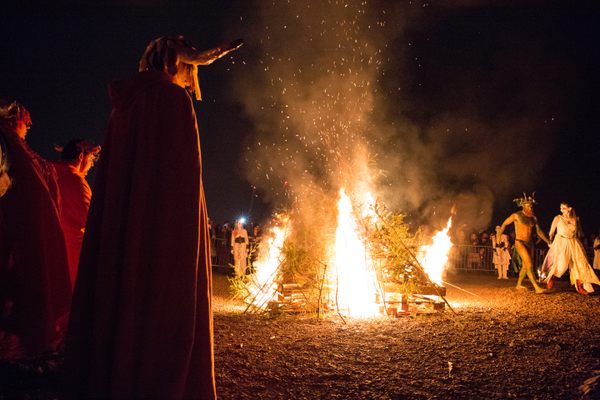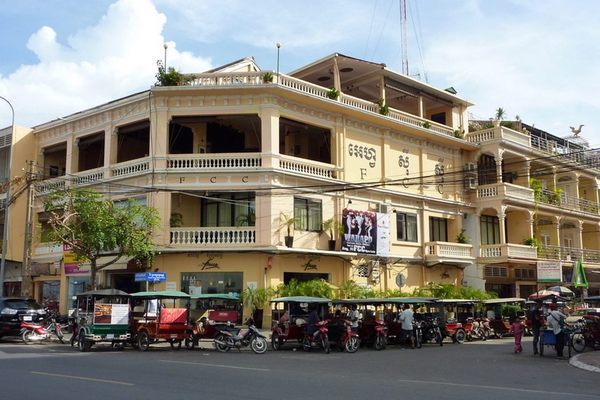

It Takes a Village to Feed Cambodia’s Ravenous Ghosts
When the gates of hell open on Pchum Ben, communities gather to feed returning ancestors with sweet and savory rice cakes.
Rotanak Ros woke to feed the ghosts before dawn. By the time the sun’s first rays began creeping over the rooftops of Phnom Penh, it would be too late—the spirits cannot stand the light. During Pchum Ben, the Khmer Festival of the Ancestors each year in September and October, the gates of hell open. With no fewer than 32 realms, the Cambodian version of hell would leave even Dante’s Virgil aghast. When the spirits of the dead slip through the porous barrier into the world of the living, they’re desperate for a reprieve. And they’re starving.
“We believe that in hell, they’re very hungry,” Ros explains. Better known to her online followers as Chef Nak, Ros is the author of Nhum—Recipes from a Cambodian Kitchen. For 15 days, spirits search for their living relatives in temples and graveyards, hoping for acts of service that prove their families have not forgotten them. As long as the living do their part, the spirits will bring blessings upon them. If their relatives fail to provide the requisite offerings, the spirits will return to their respective torments at the end of Pchum Ben—and, in their despair, pass on their misfortune. Ros says that if the spirits don’t find their relatives in the temples and graveyards, “we, the living people, will get cursed by them.”
In order to avoid the wrath of a horde of hungry ghosts, Ros and her family hurl small rice balls into the air at graveyards and temples in the morning darkness, when the spirits with the heaviest karmic burdens roam. Known as bos bai ben, the Buddhist ritual is meant to placate these ghosts, whose tiny mouths are believed to be exactly the right size for a lump of sticky rice stuffed with finely chopped sugar cane, bananas, or mung beans. “We chant and toss them in the air almost like a tennis ball or a boomerang,” Ros says. “We have to walk three rounds around the graveyard of the temple before dawn, so it requires people to really believe in it.”

While ghosts in most Western traditions abstain from bodily functions like eating, many of their Southeast Asian counterparts have no qualms about partaking in culinary offerings. Thai ghosts are partial to red Fanta, while ancestral spirits at the Hungry Ghost Festival—a celebration of Chinese origin practiced in Hong Kong, Vietnam, Singapore, Malaysia, and other countries—might enjoy oranges, congee, or rice cakes stuffed with peanuts and fried shallots.
“For me, Pchum Ben is about celebration,” Ros says. “It’s a time of gathering. It’s also for paying respects to our loved ones, keeping traditions, and using food to connect the living and the dead.”
Although Pchum Ben has a long history stretching back to the Angkorian period, the holiday has taken on a special significance in the wake of the atrocities committed by the Khmer Rouge. Between 1975 and 1979, Pol Pot’s regime murdered between 1.2 and 2.8 million Cambodians, or as much as 30 percent of the country’s population. According to Khmer Buddhist beliefs, the spirits of those who die a violent death may struggle to find the peace necessary for rebirth.

Since there is no way to know for sure if a departed relative is in a realm of heaven or hell, living relatives hope to pass good karma on to their ancestors and ease whatever suffering they might be enduring. In a country still coping with staggering loss, Pchum Ben has become a form of mourning, a collective effort to ease the afterlife transitions of those who were taken too soon. On the final day of the festivities, when the spirits head back to hell or to a new realm of the afterlife, families load up small banana-leaf boats with sweets, money, fruit, incense, and candles, then set the tiny watercraft afloat. The hope is that the spirits carry these gifts and a lighter karmic load back with them to the afterlife.
Pchum Ben is about symbolically feeding those who have shuffled off this mortal coil, but most of the feast winds up in the bellies of the living. After the sun rises each day during the festival, the cooking and the festivities continue. Although some of the dishes vary from province to province, virtually all families prepare num ansom—coconut sticky rice cakes stuffed with various fillings and wrapped in banana leaves—to take to the nearest temple as an offering for monks. It’s an act of service meant to make merit for those spirits who might need a little help from their living relatives to reach a better place in the afterlife. “We believe that the monks can transfer this good deed to our ancestors,” Ros says. “We hope this good deed helps to release them from wherever they are.”
These sticky rice cakes might be savory, such as num ansom chrouk (stuffed with pork belly), or sweet, such as num ansom chek (stuffed with banana) or num ansom aing (stuffed with grilled coconut). Making the cakes is a time-consuming, labor-intensive task best shared among family and friends. “Normally, it’s a joint effort between a few families or even a whole village to make an offering,” Ros says. “When people make it collectively in the village, it can be up to 50 kilograms [110 pounds] of sticky rice. They make hundreds and hundreds of num ansom.”
On a pragmatic level, the festival takes place during the rainy season, when monks are forbidden from traveling lengthy distances on treacherous muddy roads. The tightly wrapped sticky rice cakes, which stay fresh for days and reheat even better, are an ideal food for sustaining monastic communities during this time. Since the last three days of Pchum Ben are a national holiday, it’s also a time when families who are spread across rural areas and cities reunite. After paying their respects to the monks, they gather to dine on all kinds of dishes. Both sweet and savory num ansom feature prominently at this feast as well.
“This feast is for the late ancestors and to support monks and temples, but most importantly, it’s to keep our family and our community strong,” Ros says.
Ros believes so strongly in the importance of Khmer gastronomic traditions like this annual onslaught of num ansom that she’s dedicated her life to preserving them. Previously, Ros spent eight years working for Cambodia Living Arts, a nonprofit dedicated to saving traditional Khmer dance, music, and other performing arts that were almost lost during the Khmer Rouge. The regime was notorious for, among other things, inventing the concept of Year Zero, a complete erasure and refutation of all that had come before their reign. To enforce the idea, they massacred roughly 90 percent of the country’s intellectuals, artists, and keepers of cultural traditions.

Yet as Ros traveled throughout Southeast Asia and the United States, it struck her that little was being done to save another critical piece of Cambodia’s intangible cultural heritage. “Performing arts are very important as an art form, but they’re not an art form that we need to consume three times a day,” she says. “What about culinary arts? We need them three times a day but no one is working to preserve them. I realized that all of [our culinary traditions] are being passed down from the elderly generation verbally. Nothing is being written down. So if young students don’t want to learn, everything will be lost.”
Ros quit her job in order to document these oral recipes and traditions before they disappear. For the past four years, she has spent most of her time traveling to rural areas of Cambodia’s 24 provinces.
“I believe that Cambodia has a lot more to tell beyond the killing fields and our temples,” she says. “That’s why I spend money, energy, and time traveling around Cambodia meeting grandmas and grandpas and people who still remember the flavors and dishes cooked by their grandparents.”
In many cases, the home cooks she interviews for her YouTube videos and her research have never used measurements, preferring instead to add a “pinch of this” or a “handful of that.” Ros sees it as her duty to listen, observe, and record Khmer history for future generations. It’s her own way of honoring the ancestors, a practice she continues each year when she gathers with her family to assemble hundreds of num ansom as an offering to the ghosts of Cambodia’s past.

Num Ansom Chrouk
Courtesy of Rotanak Ros
Ingredients
7 pounds sticky rice
3 cups coconut cream
3 pounds yellow split mung beans
3 pounds pork belly
2 tablespoons salt
10 cloves garlic
1 tablespoon freshly ground black pepper
45 fresh banana leaves, 10–12 inches each
30 strings, each roughly 30 inches long
Instructions
The Night Before
1. The night before you plan to cook the num ansom, rinse the sticky rice with room-temperature water a few times to remove excess starch, until the water becomes clear. Place the rinsed rice in a large mixing bowl and cover with about an inch of water. Leave the rice at room temperature overnight, or for at least eight hours.
2. Rinse the mung beans in room-temperature water several times. Bags of mung beans occasionally contain small stones, so be sure to remove any if you see them. Allow the mung beans to soak at room temperature covered by at least an inch of water overnight, or for at least eight hours.
3. Using a mortar and pestle or a food processor, mash the garlic, 1 tablespoon salt, and black pepper together to form a smooth paste. Cut the pork belly into 15 long, flat strips, each about 1 inch wide. Spread the garlic paste evenly over the strips, then cover and refrigerate overnight.
The Next Day
4. The next morning, rinse and drain the rice several times until the water is absolutely clear. Set in a cheesecloth-lined colander to drain completely for 20 minutes. Repeat this process with the mung beans.
5. Bring the coconut cream to a boil. Remove from the heat.
6. In a large mixing bowl, combine all of the soaked and drained sticky rice with the coconut cream and 1 tablespoon salt. Mix thoroughly to combine and set aside.
7. Clean the banana leaves with a damp cloth to remove any excess dirt or grit. To assemble each of the 15 sticky rice cakes, start by placing a banana leaf on a flat surface, then place a second leaf on top. Roughly half of the surface area of the two leaves should overlap. Place a third leaf centered over the first two.
8. Place ¼ cup of sticky rice on the center of the top leaf and spread it out into an oval. The layer of rice should be about ⅓ inch thick, 8 inches long and about 4–5 inches across. On top of the rice, place about 3 tablespoons of mung beans, creating an oval-shaped mung bean layer about 7 by 4 inches.
9. Place one pork belly strip along the center of the mung bean oval. Cover the seasoned pork belly with 1 additional tablespoon of mung beans.
10. Finally, add an additional 1 tablespoon of sticky rice on top of the layer of mung beans.
11. Bring the banana leaves over the oval-shaped layers of rice, beans and pork so that the pork strip is in the center with the leaves folded up around it. Fold the ends of the banana leaves together, then fold the leaves again over themselves until the rice/bean/pork strip is tightly wrapped. Fold one end of the cylinder-shaped leaves to close the cylinder temporarily. You should now have a standing cylinder. Press it gently with a wooden spoon from the top to tighten the mixture.
12. With the cylinder upright, fold the leaves at the top to a point to close that end. Then pick up the cylinder and set on the closed end, and fold the other end shut. The cylinder should now be sealed on both ends.
13. Take two strings and tie the cylinder so that it holds its shape during cooking. At each end, close the folded cylinder, tying one end of the string, then keep wrapping the string around the cylinder. Do the same from the other end till the two strings meet in the middle to be tied.
14. In a large cooking pot place all the cakes and cover with tap water, adding a bit more water than needed to cover the cakes. Bring the water to a boil and cover with a lid. Continue boiling for four hours. Check every half hour or so, and add water to keep the cakes covered.
15. After four hours, place the cakes into a pot full of room temperature water for 3–4 minutes and then remove the cakes and place on a drying rack or in a basket to allow them to dry. Remove the banana leaves before eating.
16. The num ansom chrouk are designed to keep and travel well. If you still have leftovers after 3–4 days, grill them over a charcoal or gas grill in the banana leaves until the exterior gets browned and lightly charred.
Gastro Obscura covers the world’s most wondrous food and drink.
Sign up for our email, delivered twice a week.


































Follow us on Twitter to get the latest on the world's hidden wonders.
Like us on Facebook to get the latest on the world's hidden wonders.
Follow us on Twitter Like us on Facebook